-
【数学知识】—— 快速幂 / 扩展欧几里得算法

互质与欧拉函数
定义
 ,若
,若 ,则称 a,b 互质
,则称 a,b 互质对于三个数或更多数的情况,我们把
 的情况称为 a, b, c 互质。
的情况称为 a, b, c 互质。把
 称为 a,b,c 两两互质。后者显然是一个更强的条件
称为 a,b,c 两两互质。后者显然是一个更强的条件欧拉函数

1 ~ N 中与 N 互质的数的个数被称为欧拉函数,记为

若在算数基本定理中,
 ,则:
,则:
证明:
设 p 是 N 的质因子,1 ~ N 中 p 的倍数有 p, 2p, 3p, ..., (N/P) * p, 共 N/p 个。
同理,若 q 也是 N 的质因子,则 1 ~ N 中 q 的倍数有 N/q 个。如果我们把这 N/p + N/q 个数去掉,那么 p * q 的倍数就被排除了两次,需要再加回来一次。因此,1 ~ N 中不与 N 含有共同质因子的 p 或 q 的个数为:

实际上,上述思想被称为容斥原理。类似的,我们可以在 N 的全部质因子上使用容斥原理,就能得到 1 ~ N 中不与 N 含有共同质因子的数的个数,也是就是与 N 互质的个数
证毕。
AcWing 873. 欧拉函数
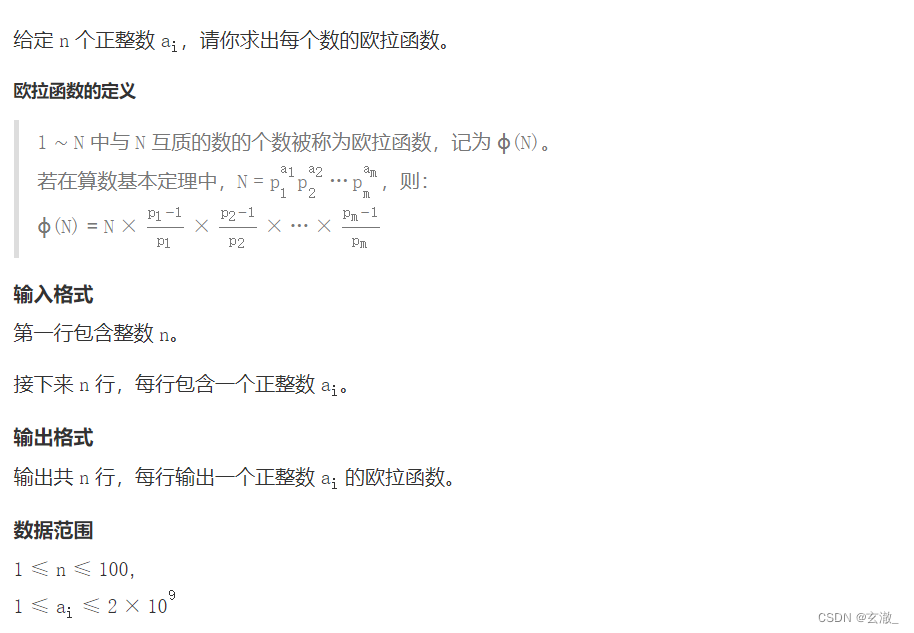
输入样例:
- 3
- 3
- 6
- 8
输出样例:
- 2
- 2
- 4
- #include
- #include
- using namespace std;
- int main()
- {
- int n;
- cin >> n;
- while(n -- )
- {
- int a; cin >> a;
- int res = a;
- for(int i = 2; i <= a / i; i ++ )
- if(a % i == 0)
- {
- res = res / i * (i - 1);
- while(a % i == 0) a /= i;
- }
- if(a > 1) res = res / a * (a - 1);
- cout << res << endl;
- }
- return 0;
- }
AcWing 874. 筛法求欧拉函数

输入样例:
6输出样例:
12
线性筛的算法回顾
- for(int i = 2; i <= n; i ++ )
- {
- if(!st[i])
- {
- primes[cnt ++ ] = i;
- }
- for(int j = 0; primes[j] <= n / i; j ++ )
- {
- st[primes[j] * i] = true;
- if(i % primes[j] == 0) break;
- }
- }
https://www.acwing.com/solution/content/28507/

- #include
- #include
- #include
- using namespace std;
- const int N = 1000010;
- typedef long long LL;
- int primes[N], cnt;
- int phi[N];
- bool st[N];
- LL get_eulers(int n)
- {
- phi[1] = 1;
- for(int i = 2; i <= n; i ++ )
- {
- if(!st[i])
- {
- primes[cnt ++ ] = i;
- phi[i] = i - 1;
- }
- for(int j = 0; primes[j] <= n / i; j ++ )
- {
- st[primes[j] * i] = true;
- if(i % primes[j] == 0)
- {
- phi[primes[j] * i] = phi[i] * primes[j];
- break;
- }
- phi[primes[j] * i] = phi[i] * (primes[j] - 1);
- }
- }
- LL res = 0;
- for(int i = 1; i <= n; i ++ ) res += phi[i];
- return res;
- }
- int main()
- {
- int n;
- cin >> n;
- cout << get_eulers(n) << endl;
- return 0;
- }
欧拉定理
若 a 与 n 互质,则

AcWing 875. 快速幂
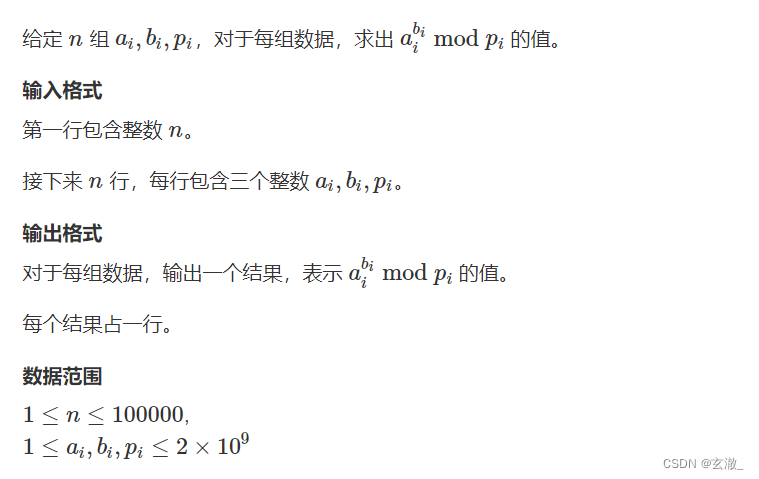
输入样例:
- 2
- 3 2 5
- 4 3 9
输出样例:
- 4
- 1
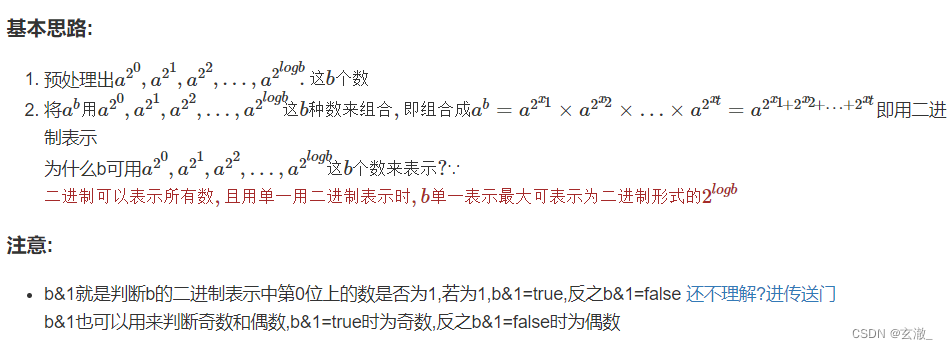
- #include
- #include
- using namespace std;
- typedef long long LL;
- int n;
- int qmi(int a, int k, int p)
- {
- int res = 1;
- while(k)
- {
- if(k & 1) res = (LL)res * a % p;
- a = (LL)a * a % p;
- k >>= 1;
- }
- return res;
- }
- int main()
- {
- cin >> n;
- while(n -- )
- {
- int a, k, p;
- scanf("%d%d%d", &a, &k, &p);
- printf("%d\n", qmi(a, k, p));
- }
- return 0;
- }
AcWing 876. 快速幂求逆元

输入样例:
- 3
- 4 3
- 8 5
- 6 3
输出样例:
- 1
- 2
- impossible
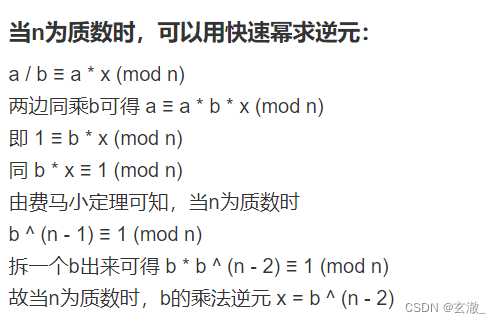
- #include
- #include
- using namespace std;
- typedef long long LL;
- LL qmi(int a, int b, int p)
- {
- LL res = 1;
- while(b)
- {
- if(b & 1) res = res * a % p;
- a = a * (LL)a % p;
- b >>= 1;
- }
- return res;
- }
- int main()
- {
- int n;
- cin >> n;
- while(n --)
- {
- int a, p;
- cin >> a >> p;
- int res = qmi(a, p - 2,p);
- if(a % p) cout << res << endl;
- else puts("impossible");
- }
- return 0;
- }
扩展欧几里得算法
裴蜀定理
对于任意的整数 a,b,一定存在一对整数非0 x,y,满足

AcWing 877. 扩展欧几里得算法

输入样例:
- 2
- 4 6
- 8 18
输出样例:
- -1 1
- -2 1
扩展欧几里得

对于求解更一般的方程 ax+by=c
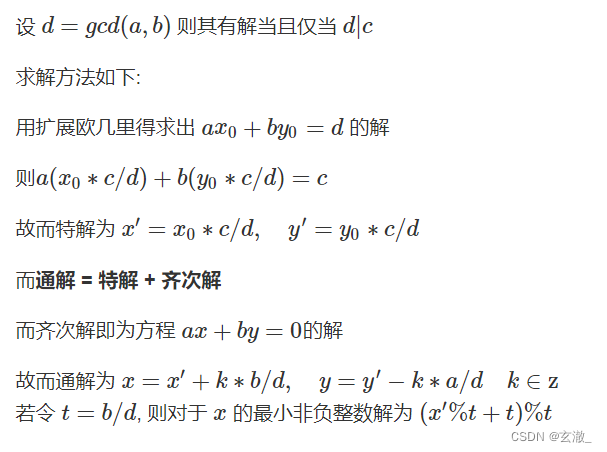
应用: 求解一次同余方程 ax≡b(modm)

- #include
- using namespace std;
- int exgcd(int a, int b, int& x, int& y)
- {
- if(!b)
- {
- x = 1, y = 0;
- return a;
- }
- int d = exgcd(b, a % b, y, x);
- y -= a / b * x;
- return d;
- }
- int main()
- {
- int n; cin >> n;
- while(n -- )
- {
- int a, b, x, y;
- scanf("%d%d", &a, &b);
- exgcd(a, b, x, y);
- printf("%d %d\n", x, y);
- }
- return 0;
- }
AcWing 878. 线性同余方程

输入样例:
- 2
- 2 3 6
- 4 3 5
输出样例:
- impossible
- -3

- #include
- using namespace std;
- typedef long long LL;
- int exgcd(int a,int b,int &x,int &y)
- {
- if(!b)
- {
- x = 1,y = 0;
- return a;
- }
- int d = exgcd(b,a % b,y,x);
- y -= a / b * x;
- return d;
- }
- int main()
- {
- int n;
- cin >> n;
- while(n --)
- {
- int a,b,m;
- scanf("%d%d%d",&a,&b,&m);
- int x,y;
- int d = exgcd(a,m,x,y);
- if(b % d) puts("impossible");
- else printf("%d\n",(LL)x * (b / d) % m);
- }
- return 0;
- }
-
相关阅读:
SpringBoot XML和JavaConfig
Postgresql 基于时间点恢复
C练题笔记之:Leetcode-827. 最大人工岛
前端项目部署
Acrobat中的颜色转换和油墨管理功能以及专色转换
通过ISO9001认证,如何实现质量体系有效性
【HCIE】04.网络安全技术
竞争与冒险 毛刺
ruoyi系统启动
每天五分钟机器学习:聚类算法k-means在实际问题中的应用
- 原文地址:https://blog.csdn.net/forever_bryant/article/details/126222314
